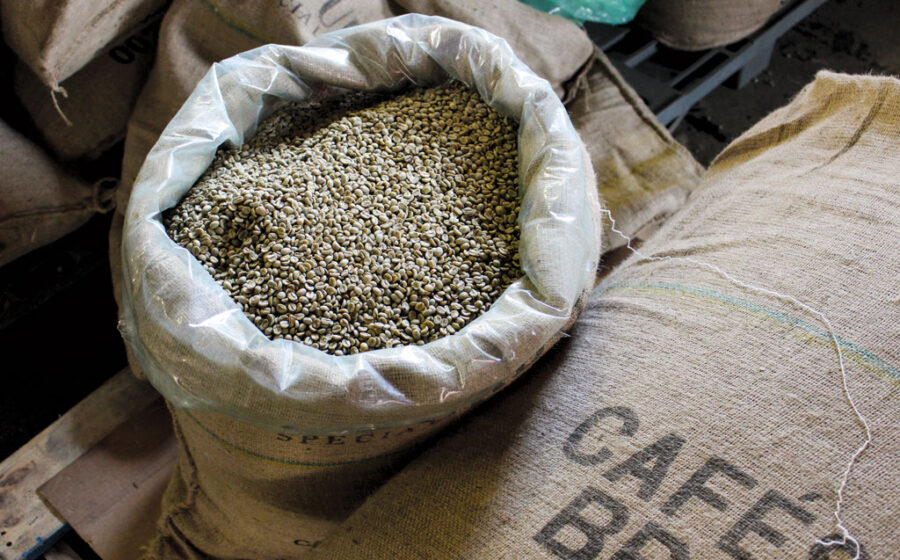[W]hen it comes to the topic of sourcing green coffees, the potential sub-topics are limitless. There are questions about pricing, contracts, business ethics, quality, logistics, and the list continues. Recently, I have been very focused on discussing the development of flavor in coffee by making slight (or massive) changes to the roast profile. One caveat I feel is necessary, is that when attempting to modulate the flavor of a coffee, you have certain limitations. One of the primary limitations is the type of green coffee you are purchasing.
As a general discussion of variables that cause a green coffee to taste a certain way, we could list a number of different items. The most complex of these being the terroir, where the coffee is grown. Terroir, in turn, is influenced by: sun exposure, soil composition, rainfall, altitude, temperature, and general geography. In addition to the circumstances in which the coffee is grown, there is the variable of the varietal of coffee. Then there’s the processing method used to remove the coffee from the fruit and parchment and then to dry it for shipment and storage. This is nowhere near an exhaustive list of variables, but it shows the inherent complexity that affects the coffee bean.
One of the exciting things of late has been how the introduction of technology, communication, and transparency on the growing side has affected expectations and flavor profiles around the world. Varietals are being experimented with in countries and climates where they’ve never before been used. Processing methods (including nuanced details and slight variations) as well as processing technology are being shared across countries and regions like never before. What this means for those who roast and taste coffee is that traditional expectations for flavor and quality are being shattered frequently. In addition, the increase in micro-lot and single-farm offerings has given further variation from the expected norm of what a coffee “tastes” like.
There comes a point where if you want a flavor disparate from what you’re getting, it’s time to source a different coffee.
To me, this is wonderfully exciting! It means that as buyers and roasters, every coffee we taste is going to have its own characteristics. For those of us who want variation and uniqueness from every lot we buy, it becomes quite easy to be enthusiastic about this trend. For those whose customer base requires steadfast flavor profiles from their blends, it can be an exciting or daunting challenge. But one question I frequently receive from clients is: “How can I make this coffee taste like x.”
That depends on the coffee. With some coffees and roast profiles, there is certainly room for movement toward the flavor profile that we are looking for. With other coffees or roast profiles, there simply isn’t.
I like to think of coffee as color. Red is red, you can take red and shift it toward orange, and you can shift it toward purple or pink, but red can never be green. If you wanted green, you would need to start with blue or yellow or green. Coffee is the same way. If you have a coffee that tastes a certain way, you have room to play with that flavor and shift it around a bit, but there comes a point where if you want a flavor disparate from what you’re getting, it’s time to source a different coffee.
There is an example I give related to acidity. You buy this wonderful washed process Ethiopian Sidamo that has a clean, crisp, citric acidity to it and tons of sucrose. This coffee’s acidity could present as grapefruit, or lime, or lemon, or Meyer lemon, or orange, or even stone-fruit. It is not going to taste like berries in the same way that the natural processed Ethiopian Sidamo may. If you wanted that flavor profile, you should have bought the natural, not the washed.
Though this is a more obvious example, it plays out in nuanced themes as well. If you have intelligently played with your flavor profile, and pushed it to the boundaries and been unable to find the flavor you were “looking for” then there stands a strong chance that it isn’t available in the coffee the same way it was from other farms, processing methods, countries, or harvest years. This is why sourcing and cupping coffees before buying them is crucial. It gives you a window into the potential of the coffee.
The bottom line is that, while we as roasters have a great deal of control over the final flavor of the coffee, we can only change what we have. Every coffee has a home, but finding out if your shop or roastery is the best place for that flavor profile is something only you can do. Develop a sourcing plan that fits your style and customer base, and source coffees that are a good fit for what you are trying to do. Then, use your skills in the craft of roasting to perfectly highlight the reasons you purchased that coffee in the first place. The final step, then, is fearlessly presenting that coffee to your customers and the industry at large.
—Rob Hoos is director of coffee and Nossa Familia Coffee in Portland, Oregon. Photo by Cynthia Meadors.
















